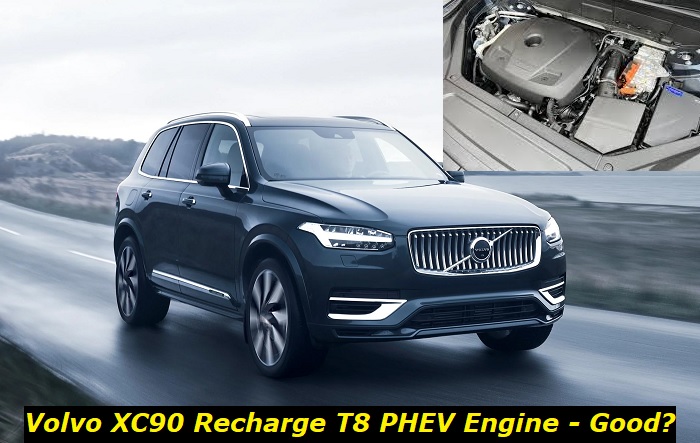The new Volvo XC90 Recharge T8 Plug-in Hybrid is one of the most wanted luxury hybrid vehicles on the market. Although the design was created in 2015, the SUV still looks very fresh and offers cool features, especially in its T8 hybrid version. While gas engines are pretty simple, the hybrid powertrain offers cool and practical technologies for owners.
Today, I will tell you more about the hybrid engine of the new Volvo XC90 Recharge T8 - I will cover its quality and durability and will also look at its tech side. It's important to know more about the powerplant before you agree to pay at least $72,000 - this is exactly the price of the cheapest trim of the hybrid XC90.

Here's what I will cover in this article:
- Key features of the powerplant in the XC90 T8 and its components.
- How long will the hybrid engine live in the Volvo SUV?
- What are some of the common problems with this engine?
- How can you prolong the life of the Volvo XC90 T8 powerplant?
Let's get started!
What should you know about the T8 Volvo XC90 engine?
The new 2023 Volvo XC90 Recharge T8 is actually the old 2015 Volvo with the technologies invented and offered in 2018. On the one hand, the technologies are pretty old and could be more efficient if they were upgraded now. But on the other hand, they are very well-researched and have lots of reviews all over the world, so I know a lot and will tell you everything today.
The hybrid version is an addition to the main better-selling gasoline version with the 2-liter turbocharged gas engine that I've already told you about in this blog. The hybrid engine uses basically the same gasoline Drive-E series engine and I will not focus on it because you may read about it in other articles.
I will focus on the hybrid technology:
- so, the heart of the powerplant is the 2-liter turbo engine - more or less the same as used in pure-gasoline versions of the SUV;
- the electric motor was updated several times and now it's a quite powerful 143-horsepower motor powering the rear wheels of the vehicle;
- the car can go all-electric or all-gas depending on the road conditions and battery health;
- the all-electric range is now about 32 miles after the battery was updated to the 18.6-kWh pack in 2021;
- you can charge this battery with EV chargers, so this is the plug-in hybrid (PHEV) that can be used as an EV with a limited range;
- the batteries are placed under the car, in the central part, are not taking a lot of useful space in the trunk or elsewhere;
- you get only AWD versions with the simple and reliable 8-speed automatic transmission which is good for a hybrid vehicle;
- the pure-gas mileage is 25 MPG but the hybrid-mode mileage can go up to 50-60 MPG depending on road conditions.
The Volvo XC90 wasn't obviously made for fuel economy and I see that Volvo could have done better with gas mileage. But they didn't care about fuel economy - they just wanted to create a vehicle that would have the fashionable and trendy hybrid feature and would still go like crazy to deliver great emotions to its owners.
So, this PHEV is not only about fuel economy, zero-emission driving, or a low-emission overall lifestyle. It's about a luxury car that wants to pretend to be eco-friendly and economical because it's just the trend. But if you think that it comes without a pinch of salt in it, you should read further.
How long will the Volve XC90 PHEV engine last?
We can't say that the 2-liter Drive-E turbocharged engine is bad but it's obviously not the most durable engine Volvo has ever made.
The gasoline engine will most likely last about 160,000 miles without major issues and then some more with some minor problems and regular repairs. I believe the optimal mileage to get rid of this car is about 180,000 miles - after this milestone, the Volve XC90 PHEV will be close to dead.
While the transmission doesn't cause any concerns with longevity, the hybrid system does. The battery pack in older cars wasn't as good as in vehicles sold after 2021. Smaller battery packs were dying as mad because they had to be recharged several times a day while you were just driving the XC90 in hybrid mode.
The main problem is that the energy consumption in this big 7-seat SUV is not economical at all. And this causes issues with the battery pack because it's drained very fast and loses its juice. The more often the battery is recharged, the faster it eventually dies.
The new battery packs are a little better but still, the Li-Ion batteries aren't eternal and are going to die at about 100,000 miles. After that, you will need to choose between two ways: to replace the expensive battery pack or to drive a pure-gas vehicle that used to be PHEV.
So, within the lifespan of the XC90 PHEV, you will also need to replace a very expensive battery pack to keep enjoying the hybrid technology till the end.
What are the common problems with the XC90 PHEV engine?
Unfortunately, the Volvo XC90 PHEV is not the most reliable car in the world with the huge amount of issues reported by owners all over the world. I've told you that the fact that this vehicle started selling in 2015 is good for us because now we know everything about it. Well, here's what I could research about this car online and from dealership mechanics:
1. TCAM issues - nightmare!
I've heard of so many cases that TCAM malfunctions in the XC90 Recharge that I just placed it in the first place on the list. This is the connectivity module and when it fails, your car may start going crazy in all possible ways.
The worst thing is that Volvo doesn't produce a certain bulletin on how to deal with this problem and mechanics are helpless in dealerships. They issue one update after another and these problems with the TCAM keep torturing the owners. In the car that costs a minimum of $72,000. Not good, should we say.
2. Battery pack premature death
I've seen reports that the battery pack was almost dead at 40,000 or 50,000 miles. This is still under warranty, so these people were lucky to have the battery pack replaced free of charge. But if this happens at 51,000 miles in your car, you better never buy lottery tickets - this is the unluckiest situation you can have with your Volvo.
These packs are very expensive and they are the soul of your PHEV, so you will obviously want to replace them. Otherwise, your PHEV Volvo will gradually turn into a $50K T5 Volvo XC90.
3. Gas engine problems
Numerous issues can cause the "Reduced Power" warning in this engine and it's hard to locate the initial problem. The engine has issues with the turbocharger, timing system, excessive oil consumption, and also many other minor and major problems that can spoil your mood pretty often.
I won't focus on the gasoline engine itself, but you should still know that this powerplant is not something you will thank Volvo for after 3-4 years of owning this vehicle.
4. Very, very long repair
In the US, people don't buy hundreds of thousands of Volvo XC90 SUVs. So, the Swedish company doesn't bother sending a lot of parts and modules to the US to let dealers promptly repair cars. If you have a faulty TCAM, you may spend 4 weeks waiting for the part. I've read a review and the person claimed to have waited 7 weeks for a simple engine repair in the dealership because some parts needed to be delivered from Europe.
This also says about the problem with repair prices because no one else will even want to repair your XC90 Recharge T8 but the dealership.
Can you prolong the lifespan of the PHEV Volvo XC90?
Obviously, the best idea you can have when owning this car is to avoid visiting the dealership but for regular maintenance. For this, you will need to remember several important tips:
- provide your Volvo with optimal regular maintenance and have it inspected yearly;
- read more about the battery health in PHEV vehicles and avoid killing the battery with the wrong driving habits;
- don't ignore warning messages and lights - they almost always tell you about potentially serious issues;
- avoid repairing the XC90 Recharge in non-dealership repair shops, the vehicle is too complicated for this;
- be ready to replace the battery pack completely or partially after the XC90 reached 80-100 thousand miles;
- avoid aggressive driving - this will affect the transmission and also add wear to your gas engine.
It's still hard to avoid TCAM failures or other glitches that may happen with this PHEV SUV and you can do basically nothing to prevent these common problems. So, if you notice that your XC90 T8 starts glitching, better immediately arrange a visit to the dealership to have the car properly tested and repaired.
About the authors
The CarAraC research team is composed of seasoned auto mechanics and automotive industry professionals, including individuals with advanced degrees and certifications in their field. Our team members boast prestigious credentials, reflecting their extensive knowledge and skills. These qualifications include: IMI: Institute of the Motor Industry, ASE-Certified Master Automobile Technicians; Coventry University, Graduate of MA in Automotive Journalism; Politecnico di Torino, Italy, MS Automotive Engineering; Ss. Cyril and Methodius University in Skopje, Mechanical University in Skopje; TOC Automotive College; DHA Suffa University, Department of Mechanical Engineering






Add comment